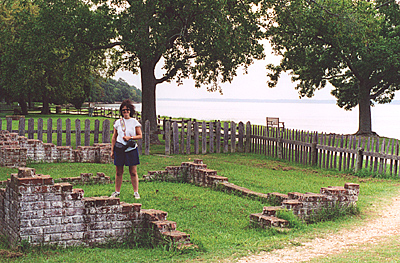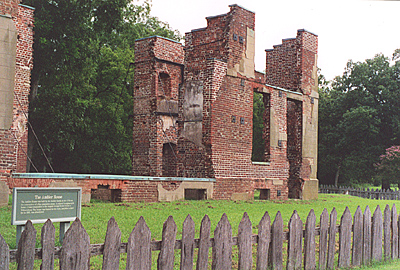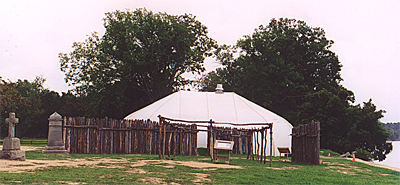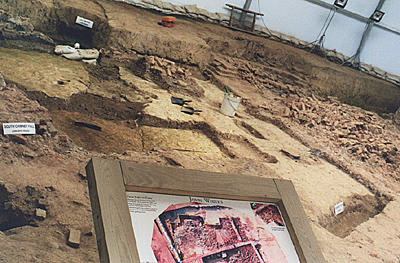 Wide walkways allow you to stroll through the New Towne.
Wide walkways allow you to stroll through the New Towne.
Brick remnants mark the spot of houses and other buildings. One thing about most of the homes, they were small.
Here you can see how a 5'3" MagWeb.com vice president of administration stands in the center of one small house.
 The most complete ruin is the Ambler Mansion, built in the mid-1700s.
The most complete ruin is the Ambler Mansion, built in the mid-1700s.
The Ambler Mansion, or what's left of it.
Most of the site looks like a big field with the occasional low brick ruins. I'm not quite sure what you should expect after 300-400 years, but there it is. Occasional ditches cross the fields, marking lot boundaries.
 However, the walk is nice, and as you return along the water, you run into a large white tentlike structure. This covers the serious excavation of the 1607 fort and other sites. The sign inside says it is the house of John White--which makes it the first White house in America. Unlike the dig at the Church, which is protected from the elements only by a tarp, these excavations are protected by a semi-permanent tent structure.
However, the walk is nice, and as you return along the water, you run into a large white tentlike structure. This covers the serious excavation of the 1607 fort and other sites. The sign inside says it is the house of John White--which makes it the first White house in America. Unlike the dig at the Church, which is protected from the elements only by a tarp, these excavations are protected by a semi-permanent tent structure.
The tent housing a portion of the fort and White's house. The fence shows a portion of the outline of the fort.
Inside, you can see how far they've gotten, although I wonder if it is an active site as there seems to be too many signs ponting out the various buildings and achitectural points. It's still neat to walk in and look around.
We passed John Smith again and climbed up into the ruined earthworks of a Confederate Fort. Those rebels! That's the second time in which they constructed fortifications atop a historical site during the Civil War (see also Yorktown). Inside the ruins is a placard marking the Robert Hunt Shrine. Hunt was the first Anglican minister to pass a collection plate in Jamestown.
 Continuing along the water, you reach the Dale House Archeological Laboratory, which houses an interactive computer whodunit. Evidently, archeologists found a skeleton buried at the site with a musket ball lodged in his leg. The touch screen detective story lets you gather facts and then try to match the clues to a person via multiple choice questions. It turns out he was an Englishman who was shot during ome trouble or another. I imagine if he was a native, some tribe would be screaming for his remains and also wanting half the island back so they could put up a casino. The English evidently don't miss their ancestor's remains. Prince Charles might want to think about that casino, though.
Continuing along the water, you reach the Dale House Archeological Laboratory, which houses an interactive computer whodunit. Evidently, archeologists found a skeleton buried at the site with a musket ball lodged in his leg. The touch screen detective story lets you gather facts and then try to match the clues to a person via multiple choice questions. It turns out he was an Englishman who was shot during ome trouble or another. I imagine if he was a native, some tribe would be screaming for his remains and also wanting half the island back so they could put up a casino. The English evidently don't miss their ancestor's remains. Prince Charles might want to think about that casino, though.
What's inside tent number 1.
Although we missed it on the way in, a three-dimnesinal holographic display of the skeleton hangs on the wall. It's a neat trick even though I probably looked like a deranged pigeon moving my head back and forth to see the display "move."
A small snack bar is on the other side of Lab. While we were there, a crew from a production company was shooting a show for the Discovery Channel. Jamestown will be one in a 10-episode series.
Continuing along the water, you come to the Memorial Cross marking the location of 300 shallow graves from the "starving time." Queen Elizabeth II came in 1957 to attend the dedication of the cross during the Jamestown festival.
Just beyond the Cross stood the storehouses which housed the original seat of government. Everything is flat now. Indeed, the statehouse/storehouse burned in 1698, which helped the colonial assembly relocate to Williamsburg the next year.
With that, we walked back to the Visitor's Center and then the car.
More Colonial Williamsburg
- Introduction and Colony History
Visitor's Center
Old Town
New Town
Five Mile Loop
Jumbo Illustration of 1600s Jamestown (monstrously slow: 1.3Mb)
Back to List of Historic Sites
Back to Travel Master List
Back to MagWeb Master List of Magazines
© Copyright 2003 by Coalition Web, Inc.
This article appears in MagWeb (Magazine Web) on the Internet World Wide Web.
Other articles covering military history and related topics are available at http://www.magweb.com